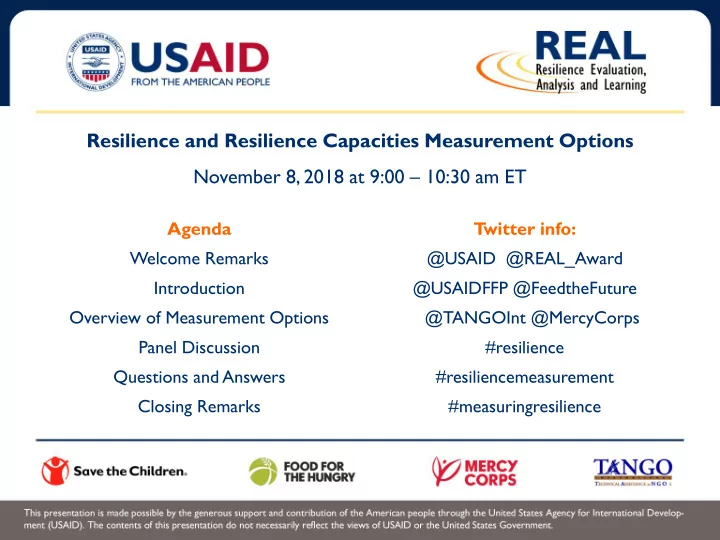

Resilience and Resilience Capacities Measurement Options November 8, 2018 at 9:00 – 10:30 am ET Agenda T witter info: Welcome Remarks @USAID @REAL_Award Introduction @USAIDFFP @FeedtheFuture Overview of Measurement Options @TANGOInt @MercyCorps Panel Discussion #resilience Questions and Answers #resiliencemeasurement Closing Remarks #measuringresilience
Presenters and Panelists Tim Frankenberger Tiffany M. Griffin President and Co-founder Adviser, Monitoring, Evaluation, and Strategic Analysis TANGO International USAID Center for Resilience Janina Mera Arif Rashid Monitoring and Evaluation Advisor Monitoring and Evaluation Team Lead USAID Bureau for Food Security USAID Office of Food for Peace Katherine Arnold Olga Petryniak Associate Director, Monitoring, Senior Director, Global Resilience Evaluation, and Learning Mercy Corps Dept. of Hunger and Livelihoods, Save the Children RESILIENCE AND RESILIENCE CAPACITIES MEASUREMENT OPTIONS NOV 8, 2018
RESILIENCE AND RESILIENCE CAPACITIES MEASUREMENT OPTIONS Practicality Customized Standardization NOT an oxymoron! • Documents designed with • the users in mind Context is important • • Resource-intensity and 6 • SOME uniformity has years of testing drove the advantages options Complement to Other Important Caveats / Resources Considerations Food security-centric Guidance Notes • • • HH/Community-centric • Short Course Series/Webinars • Resist the urge to adopt the “easiest” way forward • Evidence Briefs • Categories are not “fixed” • Assessment Tools Case Studies •
Resilience / Resilience Capacities Measurement Options USAID-funded food security activities require consistent and context-specific ways to measure resilience and resilience capacity in order to ensure effective resilience programming and Photo credit: Zacharias Abubeker/Save the Children continuous improvement based on evidence.
Resilience/Resilience Capacities Measurement Options Household Resilience and Resilience Questionnaire Capacities Measurement Community Options Questionnaire Enumerator Methodological Guidance Guidance USAID RESILIENCE AND RESILIENCE CAPACITIES MEASUREMENT OPTIONS NOVEMBER 2018
Resilience/Resilience Capacities Measurement Options • Provides an introduction to and comparison of several measurement approaches for analyzing resilience (i.e., Light, Intermediate, and Full), each of which reflects a different level of effort and budget in terms of the survey instrument and analysis used (i.e., number of questions asked and analyzed). • Intermediate and Light approaches Photo credit: TANGO International use subsets of the questions, responses, and analysis of the Full approach. Save the Children USAID RESILIENCE AND RESILIENCE CAPACITIES MEASUREMENT OPTIONS NOVEMBER 2018
Resilience/Resilience Capacities Measurement Options Full approach – resilience focus countries; full “menu” of questions, responses, and analyses Intermediate approach – programs in countries promoting resilience but not resilience focus countries; subset from Full menu Light approach – programs in countries that are not resilience focus countries; minimal subset from Full menu USAID RESILIENCE AND RESILIENCE CAPACITIES MEASUREMENT OPTIONS NOVEMBER 2018
Comparison of full, intermediate, and light approaches USAID RESILIENCE AND RESILIENCE CAPACITIES MEASUREMENT OPTIONS NOVEMBER 2018
Protocol considerations for the Light, Intermediate and Full resilience approaches USAID RESILIENCE AND RESILIENCE CAPACITIES MEASUREMENT OPTIONS NOVEMBER 2018
Household and Community Questionnaires • Together, the household and community questionnaires make up the resilience instrument. Must be used in conjunction with • the FFP core questionnaire. Photo credit: Karyn Fox, TANGO International • In the FFP questionnaire, certain modules or questions must remain and others must be deleted when used with the resilience instrument. • Replacement questions included in an annex if not used with FFP questionnaire. USAID RESILIENCE AND RESILIENCE CAPACITIES MEASUREMENT OPTIONS NOVEMBER 2018
Enumerator Guidance Provides specific instructions for enumerators to help them interpret • questions and responses in the household and community questionnaires. Not all questions are included: • Yes/no questions that do not require further explanation. − USAID RESILIENCE AND RESILIENCE CAPACITIES MEASUREMENT OPTIONS NOVEMBER 2018
Methodological Guidance • Provides specific instructions for calculating individual components of resilience capacity as well as the three resilience indices absorptive, adaptive, and transformative capacity and an overall resilience index. • Represents the Full approach (i.e., complete “menu” of questions, responses, and analyses). USAID RESILIENCE AND RESILIENCE CAPACITIES MEASUREMENT OPTIONS NOVEMBER 2018
Resilience Indices and Components of Resilience Capacity: Full Approach USAID RESILIENCE AND RESILIENCE CAPACITIES MEASUREMENT OPTIONS NOVEMBER 2018
Methodological Guidance USAID RESILIENCE AND RESILIENCE CAPACITIES MEASUREMENT OPTIONS NOVEMBER 2018
Methodological Guidance 1. Access to cash savings. This indicator is a binary (dummy) variable equal to 1 if the respondent reported that a household member regularly saves cash. • Survey question: R601 2. Access to remittances. This indicator is a binary (dummy) variable equal to 1 if the respondent reported that the household receives remittances. • Survey questions: R1101, R1103, R1105, R1107 3. Asset ownership index. Asset ownership is measured using the number of consumer durables, productive assets, and livestock owned. • Survey questions: BL H7.02, H7.03, R201, R201A USAID RESILIENCE AND RESILIENCE CAPACITIES MEASUREMENT OPTIONS NOVEMBER 2018
Thank You TANGO International Tim Frankenberger tim@tangointernational.com www.fsnnetwork.org/REAL resiliencemeasurement@gmail.com
Panel Discussion
Resilience M&E in Implementation Examples from the Sabal program in Nepal Resilience M&E tools used to: 1) Inform program design and TOC 3) Review and revise TOC 2) Inform M&E system and tools 4) Frame how we talk about resilience - Baseline survey - Routine monitoring
Ethiopia PRIME
PRIME Ethiopia Baseline and Counterfactual challenges…
PRIME Ethiopia PRIME Post-Shock Measurement Framework
Nepal PAHAL
PAHAL Nepal PAHAL Models
PAHAL Nepal PAHAL Models
PAHAL Nepal PAHAL Measures of Resilience Strategies
Key Considerations
Photo credit: TANGO International Questions & Answers Photo credit: TANGO International
Thank You www.fsnnetwork.org/REAL www.tangointernational.com www.mercycorps.org/research/resilience www.savethechildren.org
Recommend
More recommend